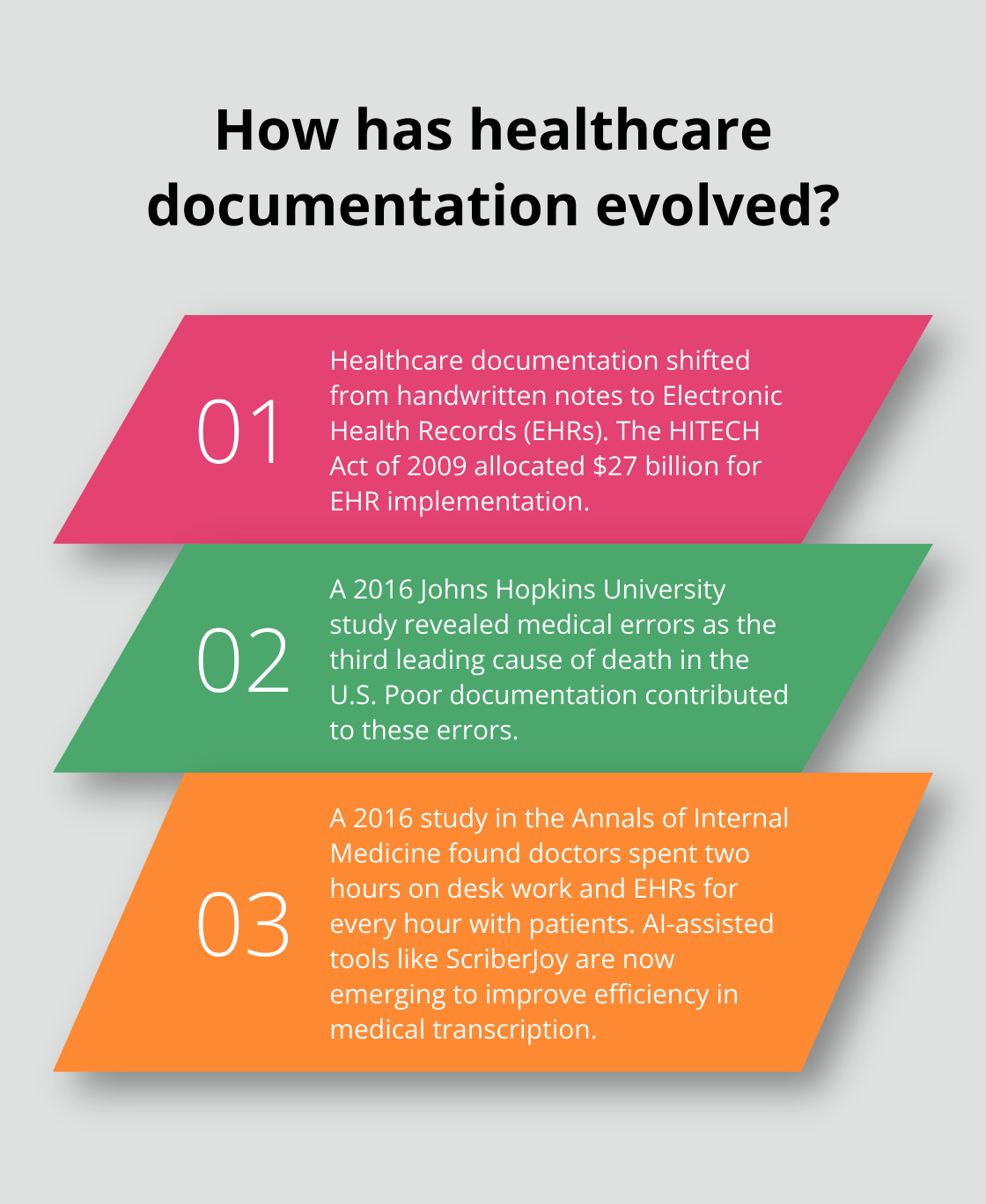AI is shaking up healthcare documentation—big time. It’s a game-changer for how medical folks jot down and handle patient information. Over at ScriberJoy, we’ve seen the magic of AI-powered solutions completely upend the way medical transcription and record-keeping get done.
And it’s not just about cutting down on paperwork…it’s about upping the ante on patient care and boosting overall healthcare outcomes. Stick around—let’s dive into how AI is flipping the script on medical documentation and what that means for the future of healthcare. Exciting stuff, folks.
From Pen and Paper to Digital Records: The Evolution of Healthcare Documentation
The Era of Handwritten Notes
Once upon a time, doctors and nurses scribbled their way through your health records-paper and pen were the tools of the trade. But here’s the kicker: most of the time, those notes were as legible as a toddler’s doodle. The endgame? Errors, miscommunication, and a lot of time spent playing Sherlock just to decode them.
Pitfalls of Paper-Based Systems
Now, let’s talk paper-one wrong move and poof, it’s gone. Not to mention, anyone with wandering fingers could sneak a peek. A big red flag waved after a 2016 study by Johns Hopkins University revealed that the third leading cause of death in the U.S. was… drum roll… medical errors. And yes, sketchy documentation had its fingerprints all over this mess.
The Digital Revolution Begins
Enter the 1960s and the birth of Electronic Health Records (EHRs)-cue the spotlight-but it wasn’t until the 2000s that they really strutted into the limelight. The HITECH Act of 2009 sweetened the deal with $27 billion to roll out these digital wonders across the board.
Early EHR Challenges
But wait, every rose has its thorns, right? So, while EHRs made documents readable and accessible, they also became a time-suck. Docs found themselves glued to screens rather than patients. A 2016 study in the Annals of Internal Medicine laid it out bare: for each hour with patients, there were nearly two more hours handcuffed to desk work and EHRs. Ouch.
AI-Assisted Documentation: The Next Frontier
Fast forward to the age of AI-our new best friend. Tools like ScriberJoy are stepping up, mixing AI magic with good old human checks to keep medical transcription spot-on. Translation? Healthcare providers can get back to what matters most-patient care-without drowning in paperwork.

Dive into the following section where AI-powered transcription is turning the healthcare world on its head, ironing out the kinks of old-school methods and early EHR growing pains while setting the stage for slicker, sharper record-keeping.
AI Transcription: The Future of Medical Documentation
The Power of AI in Healthcare Documentation
Alright, folks-AI-powered medical transcription, the unsung hero of modern healthcare. This tech loves to flex its muscles with a cocktail of speech recognition, natural language processing, and machine learning, stirring spoken words into accurately structured medical records. Yep, it’s not just a fad.
How AI Transcription Works
Here’s the scoop: throw some advanced algorithms in the mix to navigate the jungle of speech patterns and medical lingo. AI’s got ears-distinguishing between speakers, decoding context, catching those subtle shifts in tone (like a pro). Then comes the technical wizardry-audio turns into text, neatly sorted into the right compartments of the medical record.
Efficiency Boost in Healthcare
Forget about marathon documentation sessions-AI transcription chops down the hours healthcare providers usually spend wrestling with paperwork. What you get instead? More face time with patients, less burnout. It’s a win-win for the good folks in white coats.
Accuracy Improvement
And here’s where AI really struts its stuff. With humans, there’s an error rate hanging around 4%. But AI systems like ScriberJoy? Over 99% accuracy… Yeah, you heard it right. In healthcare, precision isn’t just a nice-to-have-it’s crucial (life or death kind of crucial).
Enhanced Clinical Decision-Making
Don’t think AI just jot downs notes-it’s your backseat driver for clinical decision-making. These systems flag red alerts, whisper diagnoses, and nudge follow-up actions into being based on what’s been scribbled down. It’s like having a second set of eyes (that never blink) helping to dodge the potholes of oversight.

AI-powered transcription isn’t just punching the clock. It’s a powerhouse that ramps up the quality of documentation, fuels better clinical decisions, and levels up patient care. Watch this space as it continues to evolve and shape the future of healthcare. And how does this tech revolution tilt patient care and outcomes, you ask? Hang tight for that juicy exploration-coming up next.
How AI Transforms Patient Care
Revolutionizing Time Management
AI-powered medical transcription-it’s shaking things up in a big way. Health pros leveraging these tools? They’re clocking in 37% more face time with patients than folks stuck in the past (or, you know, using traditional methods). That’s straight from the American Medical Association’s playbook.
Enhancing Clinical Decision-Making
Here’s the scoop-accuracy is king. When you’re getting documentation that’s 99% spot on, you slash the chance of messing up critical decisions. AI’s doing the heavy lifting, making sure misinterpretation’s not even in the room.
Boosting Patient Safety
Think AI just jots down notes? Nope. It’s scanning for problems, firing off warnings about drug mishaps, and catching inconsistencies-right as they happen. Real-time oversight? Check.
Streamlining Workflow
So, no more scribbling away while the patient spills their heart out. AI’s got the busywork handled. It’s about letting doctors connect-gaze engaged, rapport intact. Just pure, undivided attention on the patient, not the paperwork.
Improving Data Accessibility
Now, what’s this about data? AI systems mesh perfectly with those electronic health records, making sure every detail is at your fingertips. Continuity of care? Better believe it. Fewer repeat tests and smarter treatment? It’s all in the integration.

AI’s reworking patient care-one transcribed note at a time. We’re talking more genuine interactions, fewer slip-ups, and safer patient experiences across the board. As medicine keeps pushing into the future, AI-powered tools (looking at you, ScriberJoy) are leading the charge, blending tech and human savvy for patient care that’s off the charts.
Final Thoughts
AI has changed the game in healthcare documentation-big time. We’re talking about a move from those chicken scratch handwriting days to slick electronic systems. Tools like ScriberJoy and their AI transcription buddies are all about accuracy and speed. What does this mean for docs? More face time with patients. Less scribbling. More focus on delivering that boutique, personalized care we’re all after and making those crucial clinical calls.

Looking ahead, AI’s role in healthcare? Oh, it’s going to get crazier. We’re talking systems that’ll sift through medical data, spot health trends before they hit, and even give docs a hand with diagnosis. Embrace these AI wonders now, folks, and you’ll be surfing the wave, leading the charge in top-notch patient care. The sky’s the limit for AI in healthcare-expect major leaps in patient outcomes and medical research blazing forward.
That blend of human know-how and AI smarts? It’s the secret sauce that’s going to keep pushing the envelope in medicine. As we step further into this AI-powered healthcare era, pros who jump on board with tech like ScriberJoy will be the rock stars of patient care. AI’s revolution in healthcare? It’s not just exciting-it’s exactly what the doctor ordered for better outcomes all around.

Leave a Reply
You must be logged in to post a comment.